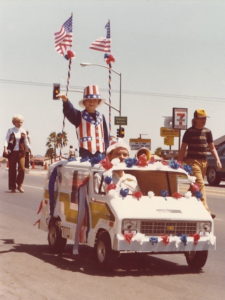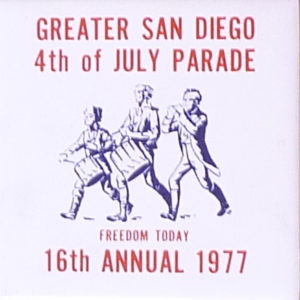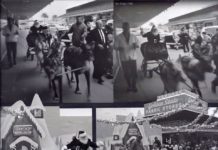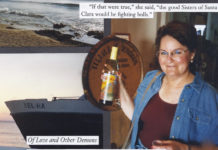
The headline of the July 8, 1962 Clairemont issue of The Sentinel proudly proclaimed, “Fourth of July Parade called Best in City.”
The first sentence of the front page article explained the headline. “The only Fourth of July parade in the city actually held on that day (a Wednesday), was, as far as partial observers could ascertain, also the best.”

The following year, the parade was described as a “howling success.” Upon arrival at the South Clairemont Recreation Center, residents met (and presumably howled at) Lupe Pena, Miss Clairemont Square, and Linda Harper, Miss Clairemont Quad.
By 1964, 35,000 spectators were expected for the Clairemont Parade. Albert J. Hickman American Legion Post 460 won first prize for a one-third scale replica of PT 109, a tribute to President John F. Kennedy, who had been assassinated the previous year.
The Kearny Mesa Hickman Post was founded in 1961. It is named after a heroic young Navy ensign from Miramar Naval Air Station whose jet stalled at 2,000 feet while on a 1959 training flight. The plane was headed toward Hawthorne Elementary School in North Clairemont, where more than 700 children were playing in the schoolyard. Rather than eject, Albert Hickman stayed at the controls and guided his disabled airplane into a canyon where it crashed and burned. The pilot lost his life.
In 1965, the parade’s Grand Marshall was retired Marine Corps General Holland “Howlin’ Mad” Smith, the father of modern amphibious warfare. There was a brief delay during the procession when vehicles carrying Spanish-American War veterans stopped before reaching the Recreation Center. The old soldiers exited the convertibles and marched past General Smith, who was seated in the review stand.
The 1966 Fourth of July fireworks show was hailed as “The finest fireworks display in the county.” The Clairemont Town Council, which had previously been castigated in 1964 by The Sentinel for its lack of involvement, was praised for the extravagant pyrotechnic display.
The largest float in the 1968 parade was a stork announcing the arrival of Clairemont’s newest baby, the prestigious Walker Scott department store in the Clairemont Square. 50,000 people enjoyed the parade and subsequent activities at the South Clairemont Rec Center. It was called “A Smashing Day.”
The 1970 Fourth of July parade was “Bigger, better than ever.” The Mayor’s Trophy went to the Clairemont Bobby Sox League for their float depicting “Washington Crossing the Delaware River.”
The “12th Annual” parade was held in 1973, but the Mayor’s Trophy was missing. A Marine Corps marching unit won the prize in 1972. Did the Marines march off with the award? The trophy was replaced in 1974 and awarded to the Navy’s 50 States Flag Corps. A woman who jumped rope for the entire length of the parade carried a sign that made more sense at the end of her performance: “I’m pooped.”
The Sentinel erroneously reported in 1974 that the “11th Annual” Clairemont Fourth of July Parade was attended by 15,000 spectators. It was the 13th year of the annual event. (Sometimes newspapers make mistakes.)
During the nation’s bicentennial celebration in 1976, an estimated “100,000 people stood along Clairemont Drive” for the Fourth of July Parade.” Mayor Pete Wilson, a Clairemont resident, was among the record turnout. A taco stand at the South Clairemont Rec sold 960 tacos, also a record.
Local TV celebrity Harold Greene, a 1961 graduate of Kearny High School, was the 1977 Grand Marshal for the parade. He was given a commemorative tile (shown below) as a souvenir of the event. My mother was impressed with the tile, so Harold graciously gave it to her.

Coverage of the Clairemont Fourth of July festivities began to fade in the newspaper. There was a picture of belly dancer Caron Jenkins in the July 8, 1979 Sentinel, but no story. In 1980, “two rock bands and, of course, the fireworks show” were mentioned. And then the celebration disappeared.
“The fireworks got to be so expensive,” said Ginger Nolan, chief fundraiser for the event which was cancelled in the early 1980s. “Our budget was $4,000 and it took all year to raise the money. I’d watch a rocket go into the air and realize the starburst cost $75 and another $65 for each for the secondary explosions. The costs add up fast.”
“Family Day” at the South Clairemont Recreation Center began in 1990 with a parade, but permits were costly and finding participants was time consuming. The parade was only held that first year.
Appreciation is extended to San Diego History Center archivist (and Clairemont resident) Jane Kenealy who hauled 19 heavy bound volumes of The Sentinel from the vault for my research on this article.
When you conduct research, sometimes, unexpected discoveries are made. I found my name in a June 3, 1962 Sentinel article under the headline, “State College to Graduate Students Who Finish Big Job.” Listed among those graduated with “Honors” was, “William G. Swank, Jr., BS, 4970 Iroquois Avenue.”
So, 53 years later, I learned that my modest GPA qualified me for honors. Either that makes me as a charter member of the every-kid-gets-a-trophy generation or the newspaper made an error…



